Recent Posts
The Dangers of Frozen Pipes and Fire Risk
2/11/2025 (Permalink)
Winter in Kansas City brings its own set of challenges, and frozen pipes are a common culprit. While the immediate concern with frozen pipes is the potential for bursting and water damage, a less obvious but equally serious risk is fire. Believe it or not, the methods people often use to thaw frozen pipes can create significant fire hazards.
The Fire Risk: A Recipe for Disaster
When a pipe freezes, the water inside expands. This expansion can cause the pipe to burst, leading to costly water damage. In an attempt to quickly fix the problem, some homeowners resort to dangerous tactics like using open flames (propane torches, lighters) or heat guns to thaw the frozen section. This is where the fire risk comes in.
- Flammable Materials: Pipes are often located near flammable materials like insulation, wood framing, drywall, and even curtains or stored items. An open flame or a heat gun can easily ignite these materials, leading to a house fire.
- Overheating: Applying direct heat to a frozen pipe can cause the pipe itself to overheat. This heat can then transfer to nearby flammable materials, even if they aren't directly exposed to the flame.
- Electrical Hazards: If the frozen pipe is near electrical wiring, the combination of water and heat can create a dangerous electrical hazard, potentially sparking a fire.
Safe Thawing Methods: What to Do Instead
Instead of risking a fire, here are some safe ways to thaw frozen pipes:
- Apply Gentle Heat: Use a hairdryer set on low to gently warm the frozen section of the pipe. Keep the hairdryer moving and avoid concentrating the heat in one spot for too long.
- Wrap with Warm Towels: Soak towels in hot water and wrap them around the frozen pipe. Replace the towels as they cool.
- Increase the Thermostat: Gradually increase the temperature in your home to help thaw the pipes slowly.
- Call a Professional: If you're unsure about how to safely thaw your pipes, or if the problem persists, it's always best to call a qualified plumber. They have the expertise and tools to thaw pipes safely and efficiently.
Prevention is Key: Avoiding Frozen Pipes in the First Place
The best way to avoid the fire risk associated with frozen pipes is to prevent them from freezing in the first place. Here are some preventative measures you can take:
- Insulate Pipes: Wrap exposed pipes, especially those in unheated areas like basements, attics, and crawl spaces, with insulation. This is one of the most effective ways to prevent freezing.
- Seal Air Leaks: Seal any gaps or cracks in your home's exterior walls and around windows and doors to prevent cold air from reaching pipes.
- Keep Interior Doors Open: On extremely cold nights, open cabinet doors under sinks and allow warm air to circulate around pipes.
- Maintain a Consistent Temperature: Keep your thermostat set to a reasonable temperature, even when you're away, to prevent your home from getting too cold.
- Drip Faucets: Let a small trickle of water run from faucets, especially those connected to pipes that are prone to freezing. Moving water is less likely to freeze than still water.
Protecting Your Home This Winter
Frozen pipes are a serious concern, but the fire risk associated with improper thawing methods is often overlooked. By taking preventative measures and using safe thawing techniques, you can protect your home from both water damage and fire hazards this winter. If you suspect you have frozen pipes, and you're not comfortable handling it yourself, don't hesitate to contact a professional. Your safety and the safety of your home are paramount.
SERVPRO® of Kansas City Midtown is here to help! If you experience water damage from burst pipes, or if you need assistance after a fire, our team of professionals is ready to respond. Contact us for fast, reliable, and expert restoration services.
Dealing with Sewer Backups in Kansas City: Protect Your Home and Health
2/11/2025 (Permalink)
A sewer backup is a messy and stressful situation for any homeowner. Beyond the immediate inconvenience, it poses significant health risks due to the contaminants present in sewage. Understanding the common causes of sewer backups in Kansas City and why professional cleanup is essential is crucial for protecting your family and your property.
What Causes Sewer Backups in Kansas City?
Several factors can contribute to sewer backups in our area:
- Tree Roots: Seeking moisture and nutrients, tree roots can infiltrate sewer pipes, causing blockages and backups. This is a common issue in many Kansas City neighborhoods.
- Aging Infrastructure: Older sewer systems can deteriorate over time, leading to cracks, leaks, and collapses. These issues restrict flow and increase the likelihood of backups.
- Heavy Rainfall: Kansas City's weather can be unpredictable. Heavy downpours can overwhelm the sewer system, especially combined systems where sewage and stormwater share the same pipes, leading to backups into homes.
- Flushing Improper Items: Flushing anything other than toilet paper can cause clogs. This includes items like wipes, diapers, paper towels, and even "flushable" wipes, which often don't break down properly. Grease buildup from cooking can also contribute to blockages.
- Blockages in the Main Sewer Line: Problems with the city's main sewer line can also cause backups in individual homes.
Why Professional Cleanup is Essential
Cleaning up a sewer backup is not a DIY job. Sewage contains a host of harmful contaminants, including bacteria (like E. coli and salmonella), viruses (like norovirus and hepatitis A), parasites, and mold. Exposure to these pathogens can cause serious illnesses, including gastrointestinal problems, respiratory infections, and skin issues.
Professional cleanup is crucial for several reasons:
- Safety: Professionals have the training, protective equipment (including respirators and specialized suits), and experience to handle sewage contamination safely. They understand how to minimize exposure to harmful pathogens.
- Thorough Cleaning and Disinfection: Simply removing the visible sewage isn't enough. Professionals use powerful disinfectants and specialized cleaning techniques to eliminate bacteria, viruses, and other contaminants, ensuring the affected area is truly sanitized.
- Mold Prevention: Sewage backups create a perfect environment for mold growth. Professionals use specialized drying equipment and techniques to remove moisture and prevent mold from developing, which can lead to further health problems and structural damage.
- Proper Disposal: Contaminated materials must be disposed of properly according to local regulations. Professionals are familiar with these regulations and will handle disposal safely and legally.
SERVPRO of Kansas City Midtown: Your Trusted Partner
SERVPRO of Kansas City Midtown understands the complexities and dangers of sewer backups. Our team of highly trained professionals is equipped to handle every aspect of the cleanup and restoration process. We will:
- Assess the Damage: We'll thoroughly inspect the affected area to determine the extent of the damage and identify the source of the backup.
- Contain the Contamination: We'll isolate the affected area to prevent the spread of contamination to other parts of your home.
- Remove the Sewage and Contaminated Materials: We'll use specialized equipment to safely remove all sewage and contaminated materials.
- Clean and Disinfect: We'll thoroughly clean and disinfect the affected area using EPA-approved antimicrobial agents.
- Dry and Dehumidify: We'll use professional-grade drying equipment to remove moisture and prevent mold growth.
- Restore Your Property: We'll restore your property to its preloss condition, including repairing or replacing damaged materials.
If you experience a sewer backup in Kansas City, contact SERVPRO® of Kansas City Midtown immediately. We're here to help you through this difficult situation and restore your property to a safe and healthy environment.
Protecting Your Home and Business During Rising Temperatures After a Snowstorm
1/9/2025 (Permalink)
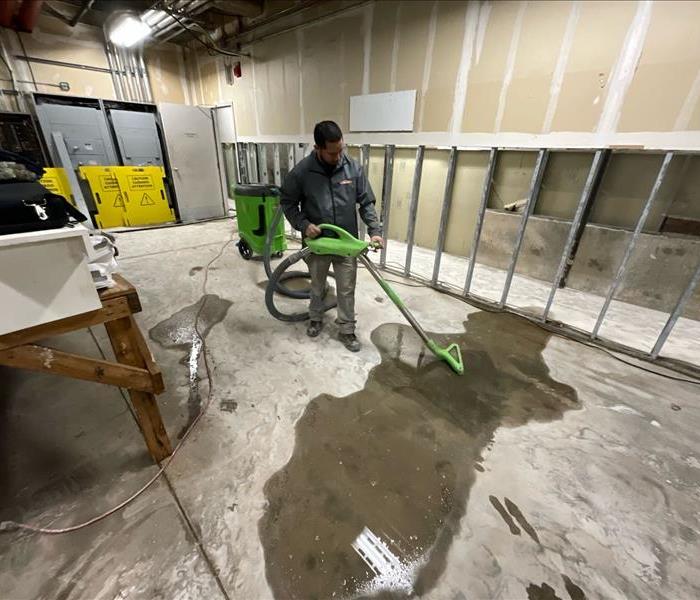 The aftermath of burst pipes after freezing temperatures.
The aftermath of burst pipes after freezing temperatures.
Winter storms can bring heavy snowfall, icy roads, and freezing temperatures. While we often prepare for the immediate effects of a snowstorm, the aftermath—especially when temperatures begin to rise—can bring unexpected challenges. One of the most common issues during this transition is burst pipes, which can cause significant water damage to your home or business.
At SERVPRO, we’re here to help® you understand the risks and take proactive steps to protect your property during this critical time.
Why Do Pipes Burst After a Snowstorm?
When temperatures drop, water in your pipes can freeze and expand, putting pressure on the pipe walls. As temperatures rise, the frozen water thaws, often leading to cracks or breaks in the pipes. The result? Water floods into your property, potentially causing costly damage to walls, flooring, and belongings.
Steps to Protect Your Property
1. Inspect Your Pipes Regularly
After a snowstorm, carefully check visible pipes in your home or business for any signs of damage or stress. Pay close attention to areas that are more susceptible to freezing, such as basements, crawl spaces, attics, and outdoor pipes.
2. Monitor Rising Temperatures
As the weather warms, keep an eye on melting snow and ice around your property. Excess water from melting snow can seep into your foundation or flood your basement if proper drainage isn’t in place.
3. Open Cabinet Doors
In your home, open cabinet doors under sinks to allow warm air to circulate around the pipes. This is particularly useful if the pipes are on exterior walls, which are more prone to freezing.
4. Check for Leaks
Turn on faucets and check for reduced water flow, which could indicate a frozen or damaged pipe. If you find a leak, turn off the water supply immediately and call a professional for assistance.
5. Ensure Proper Drainage
Clear snow and ice from around your home or business’s foundation and ensure gutters and downspouts are directing water away from the structure. This will reduce the risk of water pooling near your property.
6. Invest in Pipe Insulation
Consider insulating exposed pipes with foam or pipe sleeves to prevent freezing. This small investment can save you from major water damage repairs in the future.
What to Do if a Pipe Bursts
If you discover a burst pipe:
- Turn off the water supply immediately to prevent further flooding.
- Contact a plumber to repair the damaged pipe.
- Call SERVPRO for water damage restoration. Our team is equipped to quickly extract water, dry the affected areas, and restore your property to its pre-damage condition.
Why Choose SERVPRO?
At SERVPRO, we understand the stress that water damage can cause, whether it’s in your home or business. Our team of highly trained professionals is available 24/7 to provide emergency services. We use advanced equipment and proven techniques to ensure thorough and efficient restoration, helping you get back to normal as quickly as possible.
Don’t Wait—Prepare Today
Rising temperatures after a snowstorm can catch anyone off guard. By taking proactive steps and knowing who to call in an emergency, you can protect your home or business from significant water damage.
If you experience water damage or need assistance preparing your property, SERVPRO® of Kansas City Midtown is just a phone call away. Contact us anytime, and let us make it “Like it never even happened.”
Protecting Your Home and Business During Rising Temperatures After a Snowstorm
1/9/2025 (Permalink)
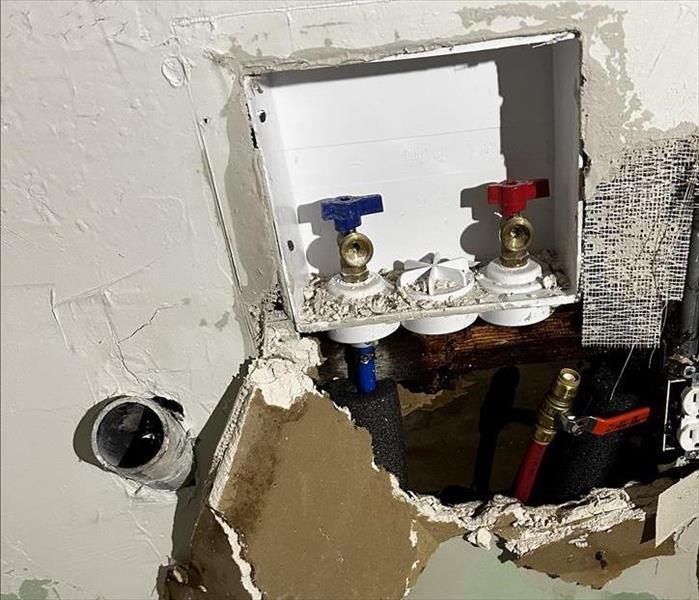 The aftermath of burst pipes after freezing temperatures.
The aftermath of burst pipes after freezing temperatures.
Winter storms can bring heavy snowfall, icy roads, and freezing temperatures. While we often prepare for the immediate effects of a snowstorm, the aftermath—especially when temperatures begin to rise—can bring unexpected challenges. One of the most common issues during this transition is burst pipes, which can cause significant water damage to your home or business.
At SERVPRO, we’re here to help® you understand the risks and take proactive steps to protect your property during this critical time.
Why Do Pipes Burst After a Snowstorm?
When temperatures drop, water in your pipes can freeze and expand, putting pressure on the pipe walls. As temperatures rise, the frozen water thaws, often leading to cracks or breaks in the pipes. The result? Water floods into your property, potentially causing costly damage to walls, flooring, and belongings.
Steps to Protect Your Property
1. Inspect Your Pipes Regularly
After a snowstorm, carefully check visible pipes in your home or business for any signs of damage or stress. Pay close attention to areas that are more susceptible to freezing, such as basements, crawl spaces, attics, and outdoor pipes.
2. Monitor Rising Temperatures
As the weather warms, keep an eye on melting snow and ice around your property. Excess water from melting snow can seep into your foundation or flood your basement if proper drainage isn’t in place.
3. Open Cabinet Doors
In your home, open cabinet doors under sinks to allow warm air to circulate around the pipes. This is particularly useful if the pipes are on exterior walls, which are more prone to freezing.
4. Check for Leaks
Turn on faucets and check for reduced water flow, which could indicate a frozen or damaged pipe. If you find a leak, turn off the water supply immediately and call a professional for assistance.
5. Ensure Proper Drainage
Clear snow and ice from around your home or business’s foundation and ensure gutters and downspouts are directing water away from the structure. This will reduce the risk of water pooling near your property.
6. Invest in Pipe Insulation
Consider insulating exposed pipes with foam or pipe sleeves to prevent freezing. This small investment can save you from major water damage repairs in the future.
What to Do if a Pipe Bursts
If you discover a burst pipe:
- Turn off the water supply immediately to prevent further flooding.
- Contact a plumber to repair the damaged pipe.
- Call SERVPRO for water damage restoration. Our team is equipped to quickly extract water, dry the affected areas, and restore your property to its pre-damage condition.
Why Choose SERVPRO?
At SERVPRO, we understand the stress that water damage can cause, whether it’s in your home or business. Our team of highly trained professionals is available 24/7 to provide emergency services. We use advanced equipment and proven techniques to ensure thorough and efficient restoration, helping you get back to normal as quickly as possible.
Don’t Wait—Prepare Today
Rising temperatures after a snowstorm can catch anyone off guard. By taking proactive steps and knowing who to call in an emergency, you can protect your home or business from significant water damage.
If you experience water damage or need assistance preparing your property, SERVPRO® of Kansas City Midtown is just a phone call away. Contact us anytime, and let us make it “Like it never even happened.”
Protecting Your Home from Water Damage During Rainy Seasons
7/20/2024 (Permalink)
As the seasons change and rain becomes more frequent, it’s essential to safeguard your home against potential water damage. Water intrusion can lead to costly repairs and disruption to your daily life. Here are some practical tips from SERVPRO of Kansas City Midtown to keep your home safe when it rains:
1. Maintain Your Roof and Gutters Your roof and gutters play a crucial role in directing rainwater away from your home. Ensure your roof is in good condition, with no missing shingles or signs of deterioration. Clean your gutters regularly to prevent clogging, which can cause water to overflow and seep into your home’s foundation.
2. Check and Seal Windows and Doors Inspect the seals around windows and doors for any gaps or cracks that could allow water to enter. Seal them with weather stripping or caulking as needed to prevent water intrusion during heavy rainstorms.
3. Monitor Your Basement and Foundation Basements and foundations are vulnerable to water damage, especially during periods of heavy rainfall. Keep an eye on your basement for signs of moisture or leaks. Ensure that your foundation is properly graded to direct water away from your home.
4. Maintain Your Sump Pump If you have a sump pump, ensure it is functioning correctly by testing it regularly, especially before the rainy season begins. Consider installing a battery backup system to ensure it continues to operate during power outages.
5. Landscape with Proper Drainage Landscaping can either help or hinder drainage around your home. Ensure that the ground slopes away from your foundation to prevent water from pooling near your home’s perimeter. Use gravel or mulch instead of soil near the foundation to improve drainage.
6. Inspect and Maintain Your Plumbing Check for leaks in your plumbing system, including pipes, faucets, and appliances like water heaters and dishwashers. Address any leaks promptly to prevent water damage and mold growth, which can be exacerbated by increased humidity during rainy seasons.
7. Be Prepared with a Water Damage Plan Despite your best efforts, water damage can still occur. Have a plan in place for how to respond quickly in case of a water emergency. Know where your main water shut-off valve is located and keep SERVPRO of Kansas City Midtown’s contact information handy for professional water damage restoration services.
Trust SERVPRO for Water Damage Restoration If water damage does occur despite your preventive measures, trust SERVPRO of Kansas City Midtown to help restore your home quickly and efficiently. Our trained technicians utilize advanced equipment and techniques to mitigate and restore water damage, ensuring your home is returned to its preloss condition as soon as possible.
By taking proactive steps to protect your home from water damage during rainy seasons, you can minimize the risk of costly repairs and maintain a safe and comfortable living environment for you and your family. Stay vigilant and prepared, and remember that SERVPRO® is here to assist you with any water damage restoration needs.
Navigating Storm Season: Tips and Support from SERVPRO® of Kansas City Midtown
6/16/2024 (Permalink)
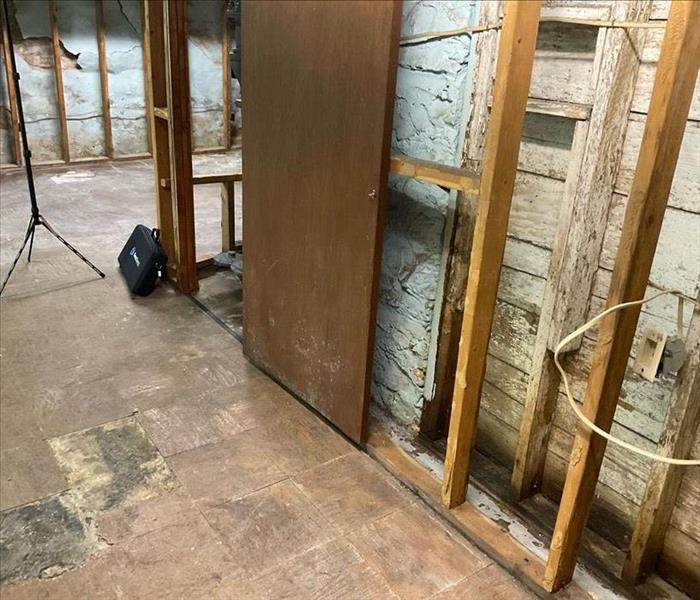 Water damage can bring mold loss in basement in Kansas City.
Water damage can bring mold loss in basement in Kansas City.
As we move deeper into storm season here in Kansas City Midtown, it's crucial to be prepared for the unpredictable weather that can come our way. Storms can bring heavy rain, high winds, and even hail, all of which can cause significant damage to homes and businesses. At SERVPRO® of Kansas City Midtown, we are committed to helping our community stay safe and prepared. Here’s a comprehensive guide to help you navigate storm season and minimize storm damage.
Understanding the Risks
Storms can vary in intensity and impact, but they often share common risks such as:
- Flooding: Heavy rain can overwhelm drainage systems, leading to water entering homes and businesses.
- Wind Damage: High winds can cause structural damage, break windows, and bring down trees.
- Hail Damage: Hailstones can damage roofs, siding, and vehicles.
Being aware of these risks can help you take the necessary steps to protect your property.
Storm Preparedness Tips
1. Inspect and Fortify Your Property
- Roof and Gutters: Regularly inspect your roof for missing or damaged shingles and ensure gutters are clear to prevent water damage.
- Windows and Doors: Install storm shutters or use impact-resistant glass. Ensure all seals are intact to prevent leaks.
- Yard Maintenance: Trim trees and shrubs, secure loose items, and remove dead or dying trees that could fall during a storm.
2. Create an Emergency Kit
Having a well-stocked emergency kit is essential. Include:
- Water and Food: At least a three-day supply of water and non-perishable food.
- First Aid Supplies: Bandages, antiseptics, medications, and any necessary personal medical supplies.
- Tools and Supplies: Flashlights, batteries, a multi-tool, and a portable phone charger.
- Important Documents: Copies of important documents in a waterproof container.
3. Develop a Family Emergency Plan
- Communication Plan: Establish how family members will contact each other if separated.
- Evacuation Plan: Know the safest routes out of your home and have a plan for where to go.
- Safe Room: Designate an interior room with no windows as your family’s safe space during a storm.
During the Storm
- Stay Informed: Keep a battery-powered weather radio or use a weather app to stay updated on storm conditions.
- Stay Indoors: Avoid windows and use your designated safe room for shelter.
- Power Safety: Use generators safely and avoid using electrical appliances if there is flooding.
After the Storm
1. Safety First
- Check for Hazards: Look for downed power lines, broken glass, and other hazards before moving around.
- Avoid Floodwaters: Floodwaters can be contaminated and dangerous.
2. Document Damage
- Photographs: Take clear photos of any damage for insurance purposes.
- Inventory: Make a list of damaged items and structural damage.
3. Contact SERVPRO® of Kansas City Midtown
If your property sustains storm damage, the team at SERVPRO® of Kansas City Midtown is here to help. We offer:
- 24/7 Emergency Response: We’re available around the clock to respond to your storm damage emergencies.
- Comprehensive Restoration Services: From water extraction and drying to structural repairs and mold remediation, we handle it all.
- Experienced Professionals: Our highly trained technicians use advanced equipment and techniques to restore your property efficiently and effectively.
Why Choose SERVPRO® of Kansas City Midtown?
- Local Expertise: As a locally owned and operated business, we understand the specific challenges of storm damage in Kansas City Midtown.
- Advanced Technology: We use the latest technology and equipment to ensure the best possible outcomes for our clients.
- Customer Focus: We prioritize your safety and satisfaction, guiding you through every step of the restoration process.
Storms can be daunting, but with the right preparation and a reliable partner like SERVPRO® of Kansas City Midtown, you can weather any storm. Stay vigilant, stay prepared, and know that we’re here to support you through any storm-related challenges.
For more information or immediate assistance, contact us today.
Mold Prevention After a Water Loss: Essential Tips from SERVPRO® of Kansas City, Midtown
5/1/2024 (Permalink)
 Containment in action: Our meticulous approach to post-water loss restoration includes effective containment measures to prevent mold growth, ensuring
Containment in action: Our meticulous approach to post-water loss restoration includes effective containment measures to prevent mold growth, ensuring
Experiencing a water loss event in your home can be overwhelming, but the aftermath doesn't end once the water is removed. One of the most pressing concerns following water damage is the risk of mold growth. Mold can start to develop within 24-48 hours of water exposure, posing health risks and causing further damage to your property. At SERVPRO® of Kansas City, Midtown, we understand the importance of taking proactive steps to prevent mold growth after a water loss. In this blog post, we'll share essential tips to help you safeguard your home and belongings.
Swift Water Extraction: The first step in mold prevention after a water loss is to remove standing water promptly. Our team at SERVPRO of Kansas City Midtown utilizes advanced equipment and techniques to extract water efficiently, minimizing the risk of mold growth.
Thorough Drying: Once the water is removed, thorough drying is crucial to prevent mold from taking hold. We employ industrial-grade air movers and dehumidifiers to dry affected areas completely, including hard-to-reach spaces like wall cavities and subflooring.
Remove Damaged Materials: Porous materials such as drywall, carpeting, and insulation that have been saturated with water may need to be removed to prevent mold growth. Our technicians assess the extent of the damage and safely dispose of any unsalvageable materials.
Clean and Disinfect: After water damage occurs, it's essential to clean and disinfect surfaces to inhibit mold growth. Our team utilizes professional-grade cleaning products and techniques to sanitize affected areas thoroughly, reducing the likelihood of mold colonization.
Monitor Moisture Levels: Even after water damage restoration is complete, it's crucial to monitor moisture levels in your home. Using moisture meters, our technicians assess moisture levels in walls, floors, and other surfaces to ensure they are within acceptable ranges.
Maintain Proper Ventilation: Proper ventilation is key to preventing moisture buildup, which can contribute to mold growth. Ensure that bathrooms, kitchens, and other high-humidity areas are well-ventilated with exhaust fans or open windows.
Address Plumbing Issues: Water damage often stems from plumbing failures or leaks. Addressing any plumbing issues promptly can help prevent future water losses and reduce the risk of mold growth.
Water damage events can leave your home vulnerable to mold growth, but with prompt action and thorough restoration, you can minimize the risk. At SERVPRO of Kansas City Midtown, our experienced team is here to assist you every step of the way, from water extraction to mold prevention. Don't hesitate to contact us for professional water damage restoration services and peace of mind knowing your home is protected against mold.
Sparks to Life: Restoring Fire-Damaged Electronics and Appliances
4/23/2024 (Permalink)
Fires not only consume structures but also wreak havoc on the electronic and electrical devices within them. The aftermath of a fire often leaves appliances and electronics damaged, both visibly and internally. In this blog, we'll explore the challenges posed by fire damage to electronics and appliances and outline the steps involved in their restoration.
Visual Inspection
Before attempting any restoration, conduct a thorough visual inspection of the electronic devices and appliances. Assess the extent of the visible damage, including charring, melted components, and smoke residue.
Safety is paramount. Ensure that all affected electronics and appliances are powered off and unplugged before attempting any restoration. This minimizes the risk of electrical shocks and further damage.
Smoke Residue Removal
Smoke residue can settle on electronic components, causing corrosion and impairing functionality. Carefully clean the surfaces using appropriate methods and materials to remove soot and smoke residue without causing further harm.
Electronics and appliances often have intricate internal components. If safe to do so, open the devices to inspect internal damage. Look for signs of melted wiring, damaged circuitry, or other issues that may impact functionality.
Cleaning and Deodorizing
Utilize specialized cleaning solutions to remove stubborn smoke odors from electronic devices. This is crucial as lingering odors can affect the usability of the appliances and electronics.
Firefighting efforts may leave behind moisture, posing an additional threat to electronics. Ensure that devices are thoroughly dried before attempting to power them on to prevent short circuits and further damage.
Testing Components
Test individual components of electronic devices to ensure they are functioning correctly. This may involve replacing damaged parts or seeking professional assistance to assess and address internal issues.
In many cases, seeking professional restoration services for electronics and appliances is advisable. Restoration experts possess the expertise and equipment to handle complex electronic systems and ensure safe and effective restoration.
Before reintroducing electronics and appliances to power sources, conduct thorough electrical safety checks. Ensure that wiring and outlets are in good condition to prevent electrical hazards.
Restoring fire-damaged electronics and appliances is a meticulous process that requires a careful balance of cleaning, testing, and, in some cases, component replacement. By following these steps and, when necessary, enlisting professional restoration services, it is possible to breathe new life into devices that may have otherwise seemed beyond repair. As we navigate the aftermath of a fire, the restoration of electronics and appliances becomes a crucial step toward restoring the functionality and comfort of a space, allowing residents to move forward with a sense of normalcy.
April Showers: Tips to Stay Prepared for Water Damage with SERVPRO®
3/27/2024 (Permalink)
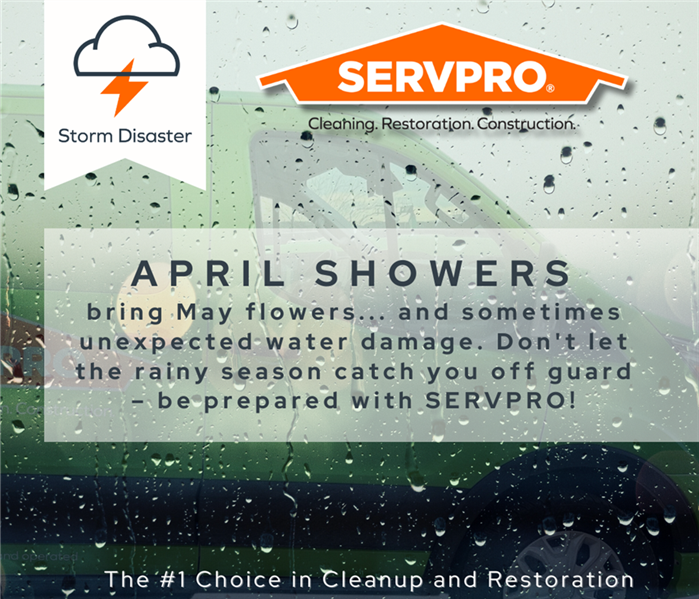 April showers may bring May flowers, but they can also bring water damage if you're not prepared.
April showers may bring May flowers, but they can also bring water damage if you're not prepared.
As April rolls in, so do the showers that characterize this transitional season. While rain brings life to the earth, it can also bring unforeseen challenges, especially when it comes to water damage in homes and businesses. Whether it's a leaking roof, a burst pipe, or flooding from heavy rainfall, water damage can wreak havoc on properties if not handled promptly and effectively. This April, SERVPRO® is here to help you stay prepared for whatever Mother Nature sends your way. Here are some essential tips to mitigate water damage and protect your property.
Inspect and Maintain Your Roof: Your roof is your first line of defense against water intrusion. Before the rainy season hits, inspect your roof for any signs of damage such as missing or cracked shingles, deteriorated flashing, or clogged gutters. Addressing these issues early can prevent leaks and potential water damage to your interior.
Check Your Plumbing: Inspecting your plumbing system is crucial for preventing water damage inside your home. Look for signs of leaks under sinks, around toilets, and behind appliances like washing machines and dishwashers. Keep an eye out for dripping faucets or unusual water stains, as these could indicate hidden leaks that need attention.
Maintain Proper Drainage: Ensure that your property has adequate drainage to redirect rainwater away from your home or business. Clean out gutters and downspouts regularly to prevent clogs and overflow, which can lead to water seeping into your foundation or basement. Consider installing extensions on downspouts to direct water at least six feet away from your property.
Install a Sump Pump: If your property is prone to flooding, installing a sump pump can be a lifesaver. A sump pump helps remove excess water from your basement or crawlspace, reducing the risk of water damage and mold growth. Test your sump pump before the rainy season begins to ensure it's in good working condition.
Invest in Water Detection Devices: Water detection devices can provide early warning of potential water damage, allowing you to take swift action before it escalates. Consider installing water sensors in areas prone to leaks or flooding, such as basements, laundry rooms, and bathrooms. These devices can alert you to moisture levels and leaks, giving you the opportunity to address issues before they cause significant damage.
Have a Water Damage Emergency Plan: In the event of water damage, having a clear plan in place can help minimize the impact on your property. Know where your main water shut-off valve is located and how to turn it off quickly to prevent further damage. Keep emergency contact information, including SERVPRO's number, readily available so you can get help fast.
Exploring Mold's Favorite Hideouts: Top 9 Hidden Places to Inspect
3/14/2024 (Permalink)
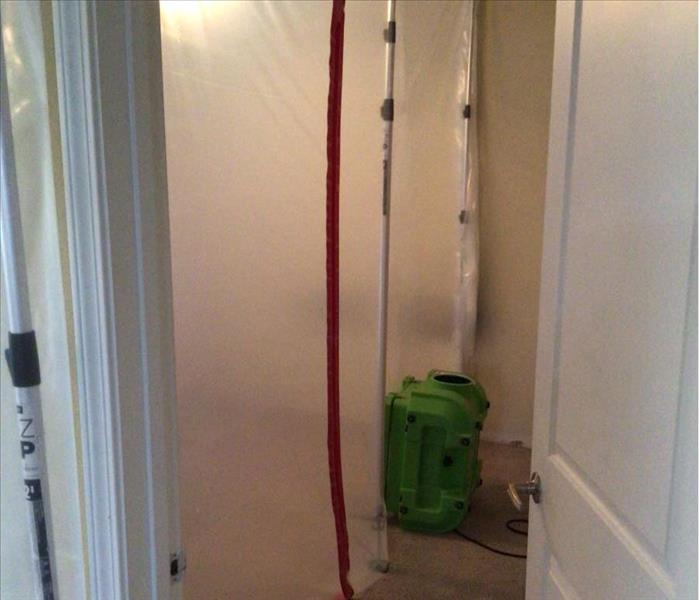 Stay vigilant, and keep your home mold-free with these tips!
Stay vigilant, and keep your home mold-free with these tips!
Mold, the unwelcome guest that lurks in the shadows, can find its way into various nooks and crannies of your home. To help you stay ahead in the battle against mold, we've compiled a list of the top 9 hidden places where mold loves to hide. Let's dive into these potential hotspots:
1. Behind Drywall
Behind drywall, especially in areas with a history of water damage, mold can quietly flourish. Regularly inspecting for discoloration or warping can help catch hidden issues early on.
2. Beneath Flooring
Moisture-prone areas like bathrooms or basements can lead to mold growth beneath flooring materials. Lift and inspect flooring periodically, especially if you've had previous water-related incidents.
3. Inside HVAC Systems
Mold spores love a ride on your HVAC system. Check and clean your air ducts regularly, as mold can accumulate and spread through the air, affecting indoor air quality.
4. Within Appliances
Dark, damp areas within appliances like dishwashers and washing machines can be breeding grounds for mold. Regularly clean and inspect these spaces to prevent mold from taking root.
5. Attic Spaces
Attics are often overlooked, but they can be vulnerable to mold growth due to poor ventilation or roof leaks. Regularly check for signs of water damage or mold to keep your attic mold-free.
6. Chimneys and Fireplaces
Chimneys and fireplaces, with their dark and often damp environments, can become hiding spots for mold. Regular inspection and cleaning can prevent mold from establishing a presence in these areas.
7. Window Sills and Tracks
Condensation and dust can create a welcoming environment for mold in window sills and tracks. Regularly clean and inspect these areas, especially in rooms with higher humidity levels.
8. Crawl Spaces
Crawl spaces are notorious for going unnoticed, making them a perfect hiding spot for mold. Regularly inspect these areas for any signs of moisture or mold growth.
9. Underneath Sink Cabinets
Sink cabinets can harbor mold due to leaks or plumbing issues. Regularly check for any signs of moisture or water damage beneath your sink cabinets.
Regular inspections and proactive maintenance in these often-overlooked areas can help you uncover and address potential mold issues before they become major problems. Stay vigilant, and keep your home mold-free with these tips!






 24/7 Emergency Service
24/7 Emergency Service





